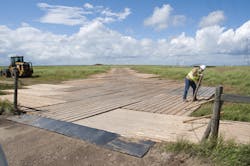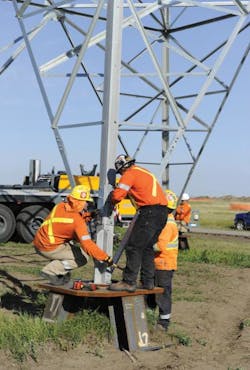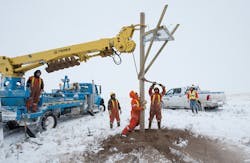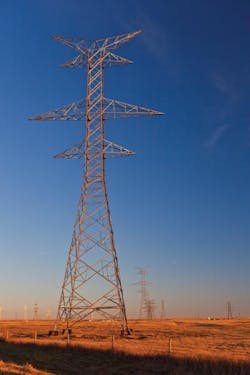New Transmission Line Crosses Protected Lands
Throughout North America, electric utilities are expanding and upgrading their infrastructure to accommodate increased electrical demand. For example, ATCO Electric recently constructed more than 220 miles of high-voltage transmission lines in Alberta, Canada, based on a forecast that load growth could double in the province by 2017 as a result of oil and gas development. The utility’s $650 million Hanna Region Transmission Development (HRTD) project increased capacity in the region and will support the connection of 700 MW of wind-generated electricity in southern Alberta.
The Alberta Electric System Operator identified the need to reinforce the electrical system in late 2009, and ATCO Electric received a permit to construct and license to operate the facilities in May 2012. Major construction began in June 2012, and the project was completed in July 2013.
Because the HRTD involved 12 interconnecting projects and crossed over environmentally protected and historic lands, ATCO Electric and Bechtel, the construction and project manager, had to identify and develop strategies for managing potential issues before they became major challenges for the field workforce. In addition, the size of the project made logistics challenging for both the field workforce and the project management team, according to Duane Ellifritt, Bechtel site manager.
“The project required that teams of people miles apart work in unison, and this was done through the aid of innovative solutions that ensured safe delivery with minimal environmental impact,” Ellifritt said.
As a result of proper planning and construction practices implemented by Valard Construction and other contractors, Bechtel was able to complete and deliver ATCO Electric’s project on time and $60 million under budget.
“We found we didn’t have to compromise cost-effectiveness for environmental responsibility,” said Sett Policicchio, president of ATCO Electric’s Transmission Division.
Routing the Line
Prior to construction, ATCO Electric tried to mitigate as many challenges as possible by conducting one of its most comprehensive public consultations to date. The utility mailed about 4,500 information packages, conducted 11 open houses and had more than 2,300 consultations with landowners.
“ATCO Electric wanted to ensure the public was aware of the project, they understood our commitment to minimizing impacts, and they had an opportunity to provide insights, concerns and suggestions based on local understanding and knowledge of the land,” Policicchio said.
Project updates were mailed to landowners to keep them up to date on the status of construction and related activities. In addition, dedicated Landowner Construction Liaisons worked with landowners to keep them informed of construction activity on or near their properties.
ATCO Electric also worked to build positive relationships with the affected communities. By gathering valuable feedback throughout the consultation process, ATCO Electric could select the best possible route for the line — a route that resulted in the least overall impact while still delivering the critical transmission infrastructure needed by the province. This required careful consideration of not only the effect of the construction process, but also how the new towers, poles, wires and substations would affect the land, people and wildlife in the area for years to come.
For example, ATCO Electric consulted with 24 aboriginal communities to provide them with the opportunity to review the project while ATCO Electric gathered information on traditional aboriginal activities in the area. When cultural sites along the route were identified, the utility worked with First Nations to develop appropriate mitigation measures.
During construction, careful preplanning also helped to alleviate potential challenges. For example, the Environmental Protection Plan (EPP) and the Historical and Archaeological Resources Protection Plan (HARPP) were both designed specifically for the HRTD. In support of these plans, the utility trained employees to follow environmental best practices, including learning the processes involved in identifying and protecting historical and archaeological resources. Because of the project’s success, these practices have been applied to other ATCO Electric projects.
“The key to the project’s success was the integration of environmental specialists and construction execution,” said Kristen Andersen, project environmental lead for Bechtel. “By ensuring construction crews knew the environmental plan, and by carefully monitoring and managing their work, we were able to avoid environmental issues that could impact project schedule and cost.”
The HRTD’s EPP identified environmental measures for ATCO Electric’s employees and contractors to follow during project construction. Along the route, the utility noted environmentally sensitive features and developed detailed plans to avoid disruption. The HRTD’s HARPP provided field personnel with the training to help them identify potential historical and archaeological resources discovered while building the project. Soon after construction began, the HARPP’s value was demonstrated when contractors discovered a centuries-old baby bison skeleton. At that point, work was halted and experts were notified.
As a result of implementation of the HARPP on the HRTD project, 145 historical and archeological resources, primarily in the Hanna area, were identified and reported to Alberta Culture. Discovered mostly by walking the line on foot, these finds were significantly more than the five finds in this area previously on record with Alberta Culture.
“ATCO Electric is extremely proud to have contributed to the discovery of these resources, which will help to preserve Alberta’s history,” Policicchio said.
During the construction of the HRTD project, the field workforce discovered fossils, historic buildings and cultural sites. As a result, this project’s HARPP has received two awards: the 2013 Award of Planning Merit for Special Studies from the Alberta Professional Planners Institute and the 2013 Richard G. Forbis Award from the Archaeological Society of Alberta, Calgary Centre.
Leveraging Technology
To successfully comply with environmental and historical guidelines, mobile technology played a key role. When on site, the Bechtel right-of-way (ROW) construction and environmental teams used mobile geographic information system (GIS) technology that provided customized information about environmental regulations, requirements and landholder/stakeholder commitments for specific land parcels and guided ROW layout.
The GIS applications acted as virtual databases to track permit status and environmental issues, which helped with logistical planning and the elimination of delays for site access. Field workers could easily see which work fronts were cleared and ready for construction.
The handheld field computers also included an integrated GPS, which allowed Bechtel teams to view, collect and update site features on maps that contained all background data, such as the towers’ locations, sensitive resources and protected adjoining areas. Environmental permit compliance was managed by linking permit expiration dates to features on the map that could have triggered actions, such as removing laminated truck mats from a wetland or watercourse crossings.
The real-time access to information enabled managers to track progress more effectively for key activities, navigate the sites and make spot decisions on planning future access, installing control measures and executing work.
“Technology was a big part of the project’s success,” Andersen said. “We used project management tools to keep the project on schedule, especially when unique historical finds were made, along with innovative compliance tools that facilitated clear and consistent communication between the construction management team and contractors in the field.”
Preserving and Protecting
Bechtel was not only responsible for ensuring the field workforce preserved the historical resources of the region, but also the environment and wildlife during construction of the new transmission lines and substations. Sixty percent of the project was constructed in environmentally sensitive areas such as wetlands, protected pasture and native grasses. Bechtel used tractor-trailers and other vehicles to haul materials efficiently and directly to the tower sites. It selectively used helicopters to string the conductor in more sensitive areas and wildlife habitats where extra precaution and protection were needed.
ATCO Electric and Bechtel undertook extensive measures to minimize environmental impacts and protect wildlife habitats. Modification to work schedules was outlined in the project’s EPP and Avian Protection Plan (APP). The EPP for the HRTD ensured environmental protection practices were implemented at every phase of construction to avoid or reduce environmental impacts.
While the EPP and HARPP plans identified and defined environmental practices, the Bechtel-developed Construction Environmental Control Plan outlined how those practices would be implemented during construction. Clearing, construction and reclamation also were carried out in accordance with the Government of Alberta’s Environmental Protection Guidelines for Electric Transmission Lines.
ATCO Electric worked with the Alberta Environment and Sustainable Resource Development and nongovernment groups to protect and preserve wildlife habitat that could be affected by construction activities or facilities. The utility also maintained restricted activity periods and setback distances for select wildlife species.
To reduce soil degradation and soil structure damage, and to avoid disrupting wildlife, the EPP required most of the construction to be carried out in the winter while the ground was frozen. This meant the majority of construction could only take place between November and mid-February.
ATCO Electric’s APP, one of the first few of its kind in Canada, also was applied to the HRTD project. This diverse program describes strategies and practices to reduce the potential for birds and fowl to collide with ATCO Electric’s transmission and distribution lines, identify opportunities to install artificial nesting platforms and observe restricted activity periods.
In the case of HRTD, ATCO Electric worked with the Government of Alberta, environmentalists and a Ferruginous Hawk expert to build 34 artificial nesting platforms. The platforms provide safe nesting locations for the birds, a species at risk in Alberta.
Because of the historical preservation and environmental guidelines as well as other factors, the HRTD project was one of the largest and most complex projects ATCO Electric has ever undertaken. ATCO, Bechtel and Valard implemented a number of new construction and environmental processes that proved to be successful on the HRTD project. As a result, they will be applied to existing and future projects, such as the Eastern Alberta Transmission Line (EATL) project currently under construction.
“Some might see these measures as challenges or obstacles, but they’re not,” Sett said. “They are a testament to our conscientious planning process and the integrity of our construction practices. It’s what you do when you want to build a project of this scope and size — the right way.”
Teamwork also was a critical part of the project, said Will Fleming, Bechtel’s program manager for the HRTD project.
“The success of this project was a collaborative effort among teams of people dedicated to quality, safety, ethics and sustainability,” he said.
Constructing Structures
For more than a year, Bechtel managed the construction of approximately 220 miles of high-voltage lines using 240-kV double-circuit lattice towers. While constructing the 144-kV line, it built a blend of both wooden H-frame single-circuit and then single- and double-circuit monopoles.
The field workforce constructed the structures using telescopic boom lifts, telehandlers, bucket trucks and cranes to assemble the steel lattice towers in two or three sections. In areas with streams and environmentally protected land, Bechtel relied on a helicopter to assist with wire stringing.
Throughout the job, the field crews used Bechtel’s GIS tools to view real-time maps and drawings in the field. The GIS tools automated everyday tasks and reduced the amount of paperwork, Fleming said.
Bechtel could plot and input information associated with environmental data, wetland delineation or archaeological restoration. The company could then design ROW access roads, issue work packages, and send the maps and drawings to field coordinators, who could then access them from their handheld devices or use hard copies. They could look at drawings and then record what they observed in real time in the field, Fleming said.
“We could use it to control and monitor the work, and the field coordinators could use the real-time database to complete environmental, safety and quality-control checklists and inspections,” Fleming said. “This allowed them to remain engaged with the workers at the work front, reduced driving time and prevented them from having to run back to the office to refer to maps, other work package content, or to complete their compliance checklists. The customization of the technology we used was a real time-saver and allowed our field coordinators to focus on the safety, quality and completion of the job at hand.”
Focusing on Safety
Because of the size and complexity of the project, the project team focused on having a productive and safe workforce.
“We had zero loss time incidents,” said Donn Grimm, president of communications, renewables and transmission for Bechtel. “We focused on safety as a core value along with quality, and we made sure that our contractors were compliant with our expectations.”
For example, the contractors on the project were required to have pre-job briefings and tailboard discussions about the potential hazards before the start of each work day. In addition, Bechtel also conducted continuous safety inspections and audits, had face-to-face meetings with the field coordinators managing the contractors and set a standard for safety through its safety checklist and automation tools. Another way Bechtel kept the field workforce safe was through a safety passport system.
“Anyone who showed up on our sites had a passport stating that they were responsible for working safely on the job site,” Grimm said. “The GIS tools, once again, proved valuable as Bechtel managers used them to conduct daily transmission environmental and safety field assessments.”
Field coordinators checked for the proper use of personal protective equipment, appropriate barricades and signage, review and witness of lifting and rigging operations, inspection of specialized equipment and proper fall protection. Rather than scan in the results, they uploaded their findings on handhelds and could aggregate the information across multiple sites to track and address trends in a timely manner, Grimm said.
Through these measures, the construction team was able to eliminate the possibilities for job-site injuries, while finishing the job on time and under budget. As a result of the new transmission line, ATCO Electric can meet the growing power needs in the region, both now and in the future.
Editor’s note: Will Fleming, Bechtel program manager for the HRTD and EATL project; Donn Grimm, Bechtel president of communications, renewables and transmission (CRT) business; Tom Lenaghan, Bechtel manager of business development for the CRT business; and Sett Policicchio, president of the ATCO Electric Transmission Division, all contributed to this article.
Companies mentioned:
ATCO Electric | www.atcoelectric.com
Bechtel | www.bechtel.com
Valard Construction | www.valard.com
Sidebar: By the Numbers
• The Hanna Region Transmission Development is comprised of 12 interconnected projects in east central Alberta, Canada.
• ATCO Electric constructed more than 220 miles of 240-kV and 144-kV transmission lines. The 144-kV line runs east from the Drumheller area to Coyote Lake. Valard Construction installed the infrastructure for the 240-kV line, which runs from Coyote Lake toward Lafine and Oyen. From Oyen, the line routes north past Pemukan.
• A total of 1,272 structures were erected, including 676 steel lattice towers, 266 H-frames and 330 monopole structures.
• ATCO Electric also constructed six new substations and upgraded 14 existing substations.
• Nearly 1,500 miles of cable were used on the project, which is enough to stretch from San Francisco to Houston.
Source: ATCO Electric and Bechtel
Sidebar: On Time and Under Budget
The Hanna Region Transmission Development project was completed on schedule and for significantly less than originally estimated. Bechtel shares how it was able to help ATCO Electric meet its objectives on the project:
1. Plan ahead. Because of the nature of the project, it was essential for the field workforce to be able to begin work as soon as possible. When the right-of-way crews were deployed, Bechtel issued a work package to the transmission crews and ensured the materials were ready and available for the crews. That way, it would have the land, materials and drawings to support the work in the field, said Tom Lenaghan of Bechtel.
2. Streamline material delivery. Bechtel also provided guidance when it came to engineering and procurement. The company surveyed ATCO Electric’s warehousing and laydown areas, helped to streamline management and logistics, and provided a complete supply chain assessment plan.
3. Closely coordinate with the crews. Rather than having the field workers jump from one section of the project to another, Bechtel worked with ATCO Electric to manage the schedule so contractors knew when the land would be available and when they could begin work on a particular section of the line in the most efficient manner.
About the Author
Amy Fischbach
Electric Utilities Operations
Amy Fischbach is the Field Editor for T&D World magazine and manages the Electric Utility Operations section. She is the host of the Line Life Podcast, which celebrates the grit, courage and inspirational teamwork of the line trade. She also works on the annual Lineworker Supplement and the Vegetation Management Supplement as well as the Lineman Life and Lineman's Rodeo News enewsletters. Amy also covers events such as the Trees & Utilities conference and the International Lineman's Rodeo. She is the past president of the ASBPE Educational Foundation and ASBPE and earned her bachelor's and master's degrees in journalism from Kansas State University. She can be reached at [email protected].





